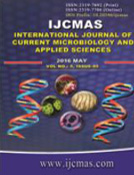


 National Academy of Agricultural Sciences (NAAS)
National Academy of Agricultural Sciences (NAAS)

|
PRINT ISSN : 2319-7692
Online ISSN : 2319-7706 Issues : 12 per year Publisher : Excellent Publishers Email : editorijcmas@gmail.com / submit@ijcmas.com Editor-in-chief: Dr.M.Prakash Index Copernicus ICV 2018: 95.39 NAAS RATING 2020: 5.38 |
In the present study, the effect of the biophysical microwave irradiation with different exposure times, on the development and germination of Wheat (Triticum spp), Barley (Hordeum vulgare L.) and Oat (Avena sativa L) after steeping, seeds in Arbil city was evaluated, the study also include comparison of α-amylase yield produced by the treated and untreated cereals, partial purification and characterization of the enzyme from the best source of enzyme treated malted oat. The specific activity of α-amylase from (Wheat, Barley and Oat) seeds in microwave treatment at the best time of exposure (10sec for wheat and 30sec for both barley and oat) compared to control were (1690.86, 2931.91 and 3817.20) and (1053.52, 2019.87and 2203.34 ) IU/mg protein respectively. The best concentrations of ammonium sulfate used for α-amylase precipitation for both control(untreated) and treated malted oat were 50% saturation, which achieved a higher specific activity of 5537.37and 7123.78 IU/mg protein, 30.78% and 32.90% yield with increase 2.56 and 1.84 in purification folds respectively. Enzyme purification by dialysis and gel filtration by using Sephadex G-75 column chromatography for control and treated malted oat had a specific activity of 33696.66, 84793.67IU/mg with 15.58, 22.002 and 13.52, 22.69% purification fold and yield respectively.With50°C optimal temperature for α-amylase activity, optimum PH activity for the catalytic reaction at pH 5. The kinetic parameters Km and Vmax of α-amylase from control and treated malted oat were 3.75 and 3.25 mg/ml respectively. Vmax was 250µmol/min. The molecular weight of the purified α-amylase from malted oat treated and untreated using SDS-PAGE electrophoresis was44KD.
 |
 |
 |
 |
 |